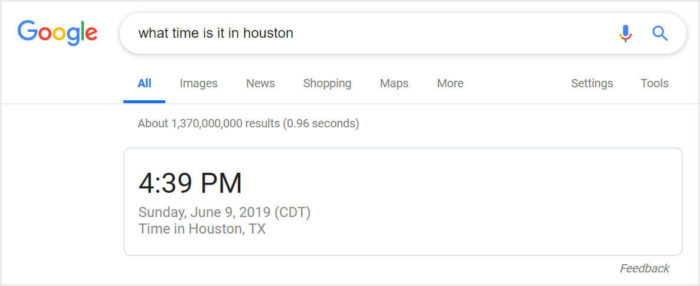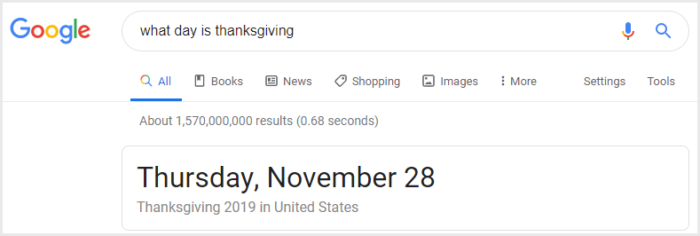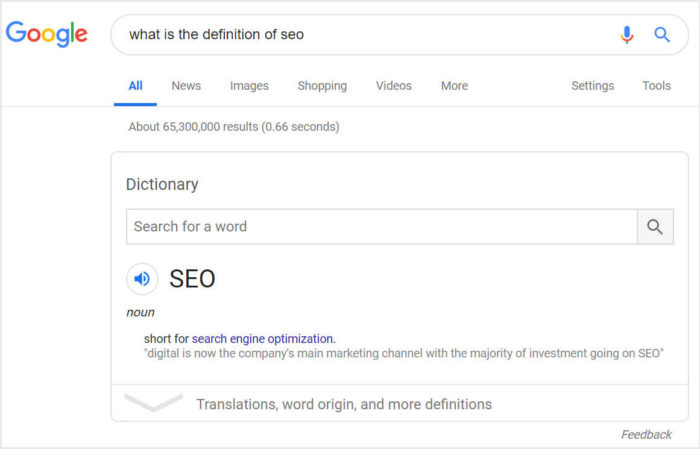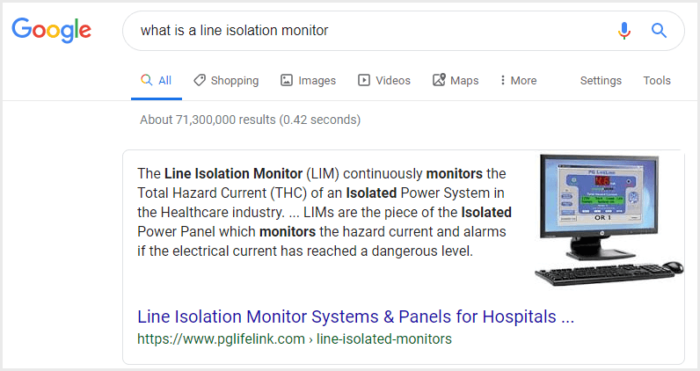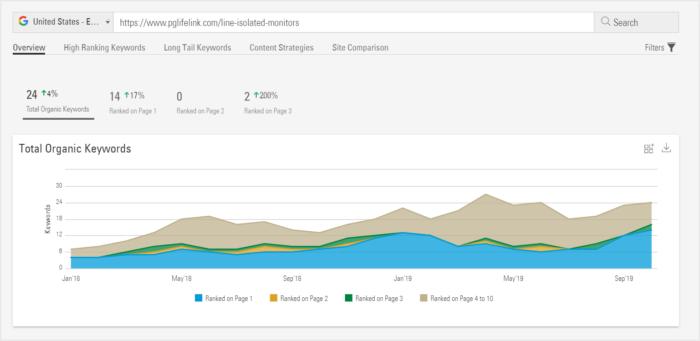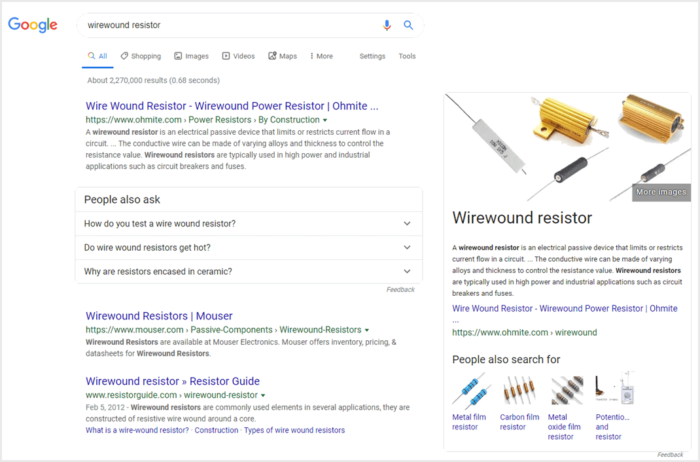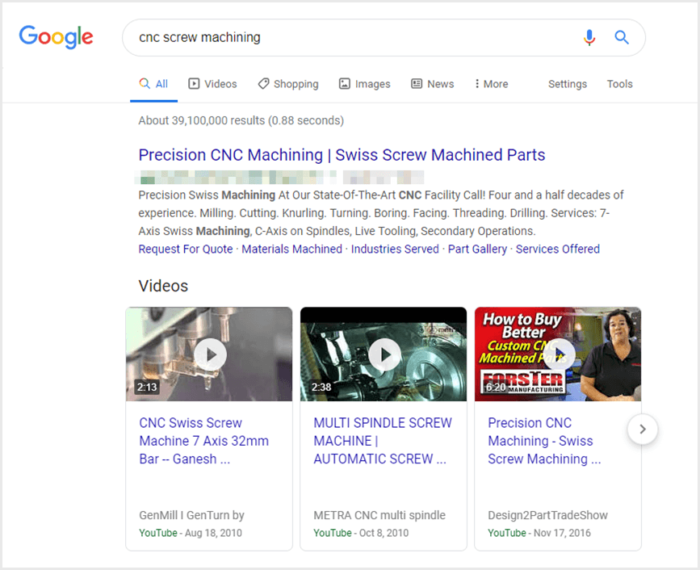November 13 2019
A Visual Guide to Understanding Google’s Organic Search Features
Part 1: Google’s Organic Search Features and What They Mean for Your Business
Keeping track of the different results Google is featuring in your space can help you determine how new or updated features may be impacting your organic traffic and leads. Since the different types of organic search results can be a little tricky to distinguish, we’ve outlined them for you below.
No-Click Search Results
No-click searches are text boxes that answer a user’s search query without them having to click through to a web page to get the answer. They are most often displayed before any other search results. Typically, you see no-click search results, also known as zero-click results, around time zones, dates, names of people and “what is the definition of” type searches.
How Common Are Zero-Click Searches?
With Google wanting to provide its users with the information they’re looking for as quickly as possible, this is a great way to do so, which is why these results are on the rise. In fact, as of August 2019, less than half of all Google searches result in a click. (Source: Sparktoro) We are seeing this shift because Google is moving towards more and more search results that include the answers to people’s questions along with an increased number of paid search ads.
How This Affects Your Marketing Strategy
With the steady rise of a user’s answers being included in their search results, the overall Click Through Rate of Google’s organic search decreased by 2% on desktop and 10% on mobile from 2016 to 2018. (Source: Search Engine Land). However, since the searches that trigger these results are typically not related to products or services, the no-click search results feature shouldn’t affect your online strategies. Instead, your strategies should be focused on the results that are shown for more transactional phrases that better represent your business and would drive more targeted visits.
Featured Snippets
February 20, 2020 – Since we wrote this, Google updated their algorithm regarding Featured Snippets. To learn more about these changes, read our blog post.
Featured snippets appear above all regular organic results, just like no-click search results. Featured Snippets, often called position zero, also contain a link to the website answering the query (shown below).
How Common Are Featured Snippets?
Ahrefs performed a study with approximately 112 million keywords in their database and found that 14 million of those keywords had a featured snippet in their search results, meaning this is a growing trend.
How This Affects Your Marketing Strategy
Featured Snippets are a growing trend, and with it being an area that Google’s latest algorithm update focused on, it’s safe to say that they aren’t going anywhere anytime soon. A Featured Snippet can also really help your website stand out in the search results should your content be featured!
The Featured Snippet shown above is an example of how our Team optimized a landing page for our client, PG Lifelink, to be shown for the query “what is a line isolation monitor.” Schema markup targeting the Featured Snippet opportunity was added to the landing page on March 27th, 2019. Since then, the landing page has seen a 34.59% year over year organic traffic increase! (1,638 organic sessions versus 1,217.) Also, organic- driven form submissions from the landing page have nearly doubled in 2019 versus all of 2018! (8 organic driven form submissions in 2018 versus 15 in 2019.)
The report above shows the number of keywords ranking on the 1st, 2nd and 3rd page of Google for PG Lifelink’s Line Isolated Monitor landing page. The page went from having 4 targeted phrases ranking on the 1st page of Google in January 2018 to 14 search phrases in October 2019.
With Google updating its algorithm to reward great content, it’s more important than ever to ensure your site has clear, user-friendly content, which can also translate into new opportunities to improve your site’s rankings and catch users during the research phase of the buying cycle.
Rich Snippets
Rich snippets are regular search results with additional information displayed. Any search result with more than a title tag, meta description and URL would be considered a Rich Snippet.
Basic Search Result (or Snippet)
The search result above only contains the page title, meta description & URL.
Another distinction of a Rich Snippet versus a Featured Snippet is that Rich Snippets are shown throughout the search results page, not just at the top. Rich Snippets can include additional information such as pricing and inventory information for e-commerce websites to videos, definitions, Questions & Answers, upcoming events, FAQs, recipes, reviews and more. (You can view the full list here)
How This Affects Your Marketing Strategy
There is no doubt that you should be factoring Rich Snippets into your marketing strategy to give your business an opportunity to stand out amongst the rest. In Part 3 of this series, we will be touching on how our B-SMART Method® can help with this.
To learn how the addition of product schema that resulted in Rich Snippets helped grow our client’s organic traffic, read this integrated marketing case study.
Maps
Businesses being listed in Google’s map results for product and service-related searches are a fairly common search feature that has been around for a while now but is a very important feature within the landscape. Since maps can show up in the organic results with or without a location modifier (like city, state, zip code or ‘near me’) included, map listings are a great way for businesses of all types and sizes to gain exposure.
How Common Are Maps in Results?
Map packs appear in nearly 30 percent of all searches, making it as common as other zero-position results such as Featured Snippets. (Source: Moz)
How This Affects Your Marketing Strategy
If a map pack or other position zero feature is also present, this could push all organic searches even lower in the results. Local optimization is important for all businesses as online searches with local intent continue to rise. First and foremost, claim your business listing on Google My Business and optimize the information. Include local information on your contact pages to show the search engine that your business is a relevant result when people are searching for your type of business in their area.
Other Factors That Can Affect the Search Landscape
Google’s refinements to their ad formats and offerings are done to meet the needs of its users, but they often interfere with the amount of space that is allotted to the organic search results, especially when they are shown in conjunction with any of the changing attributes we covered above, or when viewing results from a mobile device.
What This Means to You
The search landscape is continuing to evolve with new features and layouts, each one with the potential to impact your business in some way. It is important to keep an eye on your business’s search landscape in order to truly understand how your business is being impacted or to identify new opportunities to grow your online exposure.


